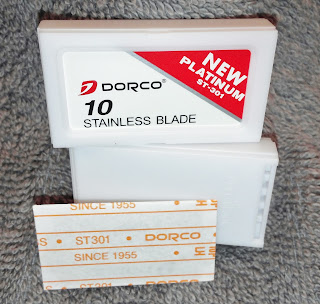Yesterday I had the brainstorm to pull out my Dorco Prime one-piece (that is, twist-to-open) razor. This razor is a high-quality instrument. It's a visual twin to the Weishi 9306-F, but it's not an identical twin. The razors (Weishi vs. Dorco) have slightly different weights, and I'm now convinced (as I suspected months ago) that the razors have different shaving characters. The Dorco Prime razor is slightly more aggressive, which is a good thing. Its shave character is such that it is still mild, but it's just aggressive enough to provide a good shave to guys like me without much risk of injury.
 Not only is the Dorco Prime razor of good quality, when one acquires the starter set, which is a terriffic value, it includes a cache of Dorco ST-301 blades, which I find to be of high quality and utility, while still being priced very reasonably.
Not only is the Dorco Prime razor of good quality, when one acquires the starter set, which is a terriffic value, it includes a cache of Dorco ST-301 blades, which I find to be of high quality and utility, while still being priced very reasonably.Another nice aspect of the Dorco Prime starter set is the nice case for the razor. It is a cut above the typical plastic case that comes with some razors.
I'm going to continue to use the Dorco Prime razor, which has now been awarded a place in my in-bathroom shaving drawer. This, in addition to my favorite Merkur 33C, will be one of the razors that I go to for daily use. So if you are one who likes the convenience and general performance of a one-piece razor, and also likes a relatively mild shave character, I would suggest that you give the Dorco Prime marque another look.
Happy shaving!



